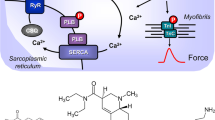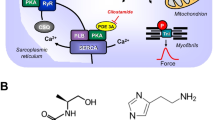Abstract
In segments of human right atrial appendages preincubated with [3H]noradrenaline and superfused with physiological salt solution containing desipramine and corticosterone, we determined the effects of 5-hydroxytryptamine (5-HT) receptor agonists and antagonists on tritium overflow evoked by transmural electrical stimulation (2 Hz).
Tritium overflow was inhibited by 5-HT, 5-carboxamidotryptamine (5-CT), 5-methoxytryptamine (5-McOT), 5-methoxy-3(1,2,3,6-tetrahydro-4-pyridinyl)-1H indole succinate (RU 24969) and sumatriptan. Yohimbine and oxymetazoline (in the presence of idazoxan) also inhibited tritium overflow. The inhibitory potency of the drugs was significantly correlated with their affinity for 5-HTID receptors in human brain and for cloned human 5-HT1Dα and 5-HT1Dβ receptors, but not with their affinity for 5HT1B, 5-HT1E, 5-HT1F, 5-HT2A, 5-HT2B, 5-HT2C, 5-HT3, 5-HT5A, 5-HT5B and 5-HT7 receptors. The potency order 5-CT >5-HT >5-MeOT is opposite to the order of affinities reported for 5-HT6 binding sites. The preferential 5-HT1A receptor agonist 8-hydroxy-2-(di-n-propylamino)tetraline (up to 0.3 μM) and the selective 5-HT4 receptor agonist cisapride (up to 1 μM) failed to inhibit tritium overflow. L-694,247, a potent 5-HTIDβ receptor agonist, did not inhibit tritium overflow, but counteracted the inhibitory effect of 5-HT. Ketanserin at a concentration which should block 5-HT1Da but not 5-HT1Dβ receptors and methiothepin at a concentration which may be assumed to block both 5-HT1Dα and 5-HT1Dβ receptors antagonized the inhibitory effect of 5-HT. Propranolol and ondansetron did not modify the 5-HT-induced inhibition of release. In conclusion, noradrenaline release in human right atrial appendages is inhibited via 5-HT receptors which are located on the noradrenergic axon terminals. These inhibitory presynaptic 5-HT receptors belong to the 5-HTID subfamily. The ability of ketanserin to antagonize the inhibitory effect induced by activation of these receptors suggests that they can be subclassified as 5-HT1Dα.
Similar content being viewed by others
References
Adham N, Kao H-T, Schechter L, Bard J, Olsen M, Urquhart D, Durkin M, Hartig PR, Weinshank RL, Branchek TA (1993) Cloning of another human serotonin receptor (5-HT-IF): a fifth 5-HT-1 receptor subtype coupled to the inhibition of adenylate cyclase. Proc Natl Acad Sci USA 90: 408–412
Bard JA, Zgombick J, Adham N, Vaysse P, Branchek ThA, Weinshank RL (1993) Cloning of a novel human serotonin receptor (5HT-7) positively linked to adenylate cyclase. J Biol Chem 268: 23422–23426
Beer MS, Stanton JA, Bevan Y, Heald A, Reeve AL Street LJ, Matassa VG, Hargreaves RJ, Middlemiss DN (1993) L-694,247: a potent 5-HTID receptor agonist. Br J Pharmacol 110: 1196–1200
Bühlen M, Fink K, Böing C, Göthert M (1996) Evidence for presynaptic location of inhibitory 5-HT1Dβ-like autoreceptors in the guinea-pig brain cortex. Naunyn-Schmiedeberg's Arch Pharmacol 353:281–289
Fink K, Zentner J, Göthert M (1995) Subclassification of presynaptic 5-HT autoreceptors in the human cerebral cortex as 5-HT1Dβ receptors. Naunyn-Schmiedeberg's Arch Pharmacol 352: 451–454
Göthert M, Kollecker P, Rohm N, Zerkowski HR (1986) Inhibitory presynaptic 5-hydroxytryptamine (5-HT) receptors on the sympathetic nerves of the human saphenous vein. Naunyn-Schmiedeberg's Arch Pharmacol 332: 317–323
Göthert M, Fink K, Frölich D, Likungu J, Molderings GJ, Schlicker E, Zentner J (1995) Presynaptic 5-HT auto- and heteroreceptors in the human central and peripheral nervous system. Behav Brain Res (in press)
Hartig PR, Branchek TA, Weinshank RL (1992) A subfamily of 5-HTID receptor genes. Trends Pharmacol Sci 13:152–159
Heald A, Stanton JA, Osborne SA, Middlemiss DN, Beer MS (1994) [3H]L-694,247 labels the 5-HT1Dβ receptor in pig caudate membranes. Eur J Pharmacol 264: 213–216
Hoyer D, Schoeffter P (1991) 5-HT receptors: subtypes and second messengers. J Recep Res 11: 197–214
Hoyer D, Clarke DE, Fozard JR, Hartig PR, Martin GR, Mylecharane EJ, Saxena PR, Humphrey PPA (1994) VII. International Union of Pharmacology. Classification of receptors for 5-hydroxytryptamine (serotonin). Pharmacol Rev 46:157–203
Kaumann AJ, Frenken M, Posival H, Brown AM (1994) Variable participation of 5-HT1-like receptors and 5-HT2 receptors in serotonin-induced contraction of human isolated coronary arteries. Circulation 90: 1141–1153
Kilpatrick GJ, Butler A, Hagan RM, Jones BJ, Tyers MB (1990) [3H]GR67330, a very high affinity fgand for 5-HT3 receptors. Naunyn-Schmiedeberg's Arch Pharmacol 342: 22–30
Matthes H, Boschert U, Amlaiky N, Grailhe R, Plassat J-L, Muscatelli F, Mattei M-G, Hen R (1993) Mouse 5-hydroxytryptamine5A and 5-hydroxytryptamine5B receptors define a new family of serotonin receptors: cloning, functional expression, and chromosomal localization. Mol Pharmacol 43: 313–319
Molderings GJ, Göthert M (1990) Mutual interaction between presynaptic α2-adrenoceptor and 5-HTIB receptor on the sympathetic nerve terminals of the rat inferior vena cava. Naunyn-Schmiedeberg's Arch Pharmacol 341: 391–397
Molderings GJ, Fink K, Schlicker E, Göthert M (1987) Inhibition of noradrenaline release via presynaptic 5-HT1B receptors of the rat vena cava. Naunyn-Schmiedeberg's Arch Pharmacol 336: 245–250
Molderings GJ, Werner K, Likungu J, Göthert M (1990) Inhibition of noradrenaline release from the sympathetic nerves of the human saphenous vein via presynaptic 5-HT receptors similar to the 5HT1D subtype. Naunyn-Schmiedeberg's Arch Pharmacol 342: 371–377
Molderings GJ, Colling E, Likungu J, Jakschik J, Göthert M (1993) Modulation of noradrenaline release from the sympathetic nerves of the human saphenous vein and pulmonary artery by presynaptic EP3- and DP-receptors. Br J Pharmacol 111: 733–738
Molderings GJ, Frölich D, Göthert M (1995) Pharmacological characterization of the inhibitory presynaptic 5-HT receptors on the sympathetic nerves of human atrial appendages. Naunyn-Schmiedeberg's Arch Pharmacol 351 [Suppl]: R142
Peroutka SJ, McCarthy BG (1989) Sumatriptan (GR43175) interacts selectively with 5-HTIB and 5-HTID binding sites. Eur J Pharmacol 163: 133–136
Schmidt AW Peroutka SJ (1990) Quantitative molecular analysis predicts 5-hydroxytryptamine3 receptor affinity. Mol Pharmacol 38: 511–516
Schoeffter P, Hoyer D (1991) Interaction of the α-adrenoceptor agonist oxymetazoline with serotonin 5-HTIA, 5-HT1B, 5-HTIC and 5-HTID receptors. Eur J Pharmacol 196: 213–216
Schoeffter P, Waeber C, Palacios JM, Hoyer D (1988) The 5-hydroxytryptamine 5-HTID receptor subtype is negatively coupled to adenylate cyclase in calf substantia nigra. Naunyn-Schmiedeberg's Arch Pharmacol 337: 602–608
Sharif NA, Wong EHF, Loury DN, Stefanich E, Michel AD, Eglen RM, Whiting RL (1991) Characteristics of 5-HT3 binding sites in NG108–15, NCB-20 neuroblastoma cells and rat cerebral cortex using [3H]quipazine and [3H]-GR65630 binding. Br J Pharmacol 102:919–925
Starke K (1977) Regulation of noradrenaline release by presynaptic receptor systems. Rev Physiol Biochem Pharmacol 77:1–124
Starke K, Göthert M, Kilbinger H (1989) Modulation of neurotransmitter release by presynaptic autoreceptors. Physiol Rev 69: 864–898
Tsou A, Kosaka A, Bach C, Zuppan P, Yee C, Tom L, Alvarez R, Ramsey S, Bonhaus DW Stefanich E, Jakeman L, Eglen RM, Chan HW (1994) Cloning and expression of a 5-hydroxytryptamine7 receptor positively coupled to adenylyl cyclase. J Neurochem 63:456–464
Waeber C, Schoeffter P, Palacios JM, Hoyer D (1988) Molecular pharmacology of 5-HTID recognition sites: radioligand binding studies in human, pig and calf brain membranes. Naunyn-Schmiedeberg's Arch Pharmacol 337: 595–601
Wainscott DB, Cohen ML, Schenck KW, Audia JE, Nissen JS, Baez M, Kursar JD, Lucaites VL, Nelson DL (1993) Pharmacological characteristics of the newly cloned rat 5-hydroxytryptamine2F receptor. Mol Pharmacol 43: 419–426
Weinshank RL, Zgombick JM, Macchi MJ, Branchek TA, Hartig PR (1992) Human serotonin]D receptor is encoded by a subfamily of two distinct genes: 5-HTIDα and 5-HT1Dβ. Proc Natl Acad Sci USA 89: 3630–3634
Zgombick JM, Schechter LE, Macchi M, Hartig PR, Branchek TA, Weinshank RL (1992) Human gene S31 encodes the pharmacologically defined serotonin 5-hydroxytryptamine1E receptor. Mol Pharmacol 42: 180–184
Zgombick JM, Schechter LE, Kucharewicz SA, Weinshank RL, Branchek TA (1995) Ketanserin and ritanserin discriminate between recombinant human 5-HT1Dα and 5-HT1Dβ receptor subtypes. Eur J Pharmacol 291: 9–15
Zifa E, Fillion G (1992) 5-Hydroxytryptamine receptors. Pharmacol Rev 44: 401–457
Author information
Authors and Affiliations
Rights and permissions
About this article
Cite this article
Molderings, G.J., Frölich, D., Göthert, M. et al. Inhibition of noradrenaline release via presynaptic 5-HT1Da receptors in human atrium. Naunyn-Schmiedeberg's Arch Pharmacol 353, 272–280 (1996). https://doi.org/10.1007/BF00168628
Received:
Accepted:
Issue Date:
DOI: https://doi.org/10.1007/BF00168628




